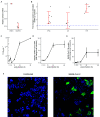ILRUN Downregulates ACE2 Expression and Blocks Infection of Human Cells by SARS-CoV-2
- PMID: 33963054
- PMCID: PMC8274604
- DOI: 10.1128/JVI.00327-21
ILRUN Downregulates ACE2 Expression and Blocks Infection of Human Cells by SARS-CoV-2
Abstract
The human protein-coding gene ILRUN (inflammation and lipid regulator with UBA-like and NBR1-like domains; previously C6orf106) was identified as a proviral factor for Hendra virus infection and was recently characterized to function as an inhibitor of type I interferon expression. Here, we have utilized transcriptome sequencing (RNA-seq) to define cellular pathways regulated by ILRUN in the context of severe acute respiratory syndrome coronavirus 2 (SARS-CoV-2) infection of Caco-2 cells. We find that inhibition of ILRUN expression by RNA interference alters transcription profiles of numerous cellular pathways, including upregulation of the SARS-CoV-2 entry receptor ACE2 and several other members of the renin-angiotensin aldosterone system. In addition, transcripts of the SARS-CoV-2 coreceptors TMPRSS2 and CTSL were also upregulated. Inhibition of ILRUN also resulted in increased SARS-CoV-2 replication, while overexpression of ILRUN had the opposite effect, identifying ILRUN as a novel antiviral factor for SARS-CoV-2 replication. This represents, to our knowledge, the first report of ILRUN as a regulator of the renin-angiotensin-aldosterone system (RAAS). IMPORTANCE There is no doubt that the current rapid global spread of COVID-19 has had significant and far-reaching impacts on our health and economy and will continue to do so. Research in emerging infectious diseases, such as severe acute respiratory syndrome coronavirus 2 (SARS-CoV-2), is growing rapidly, with new breakthroughs in the understanding of host-virus interactions to assist with the development of innovative and exciting therapeutic strategies. Here, we present the first evidence that modulation of the human protein-coding gene ILRUN functions as an antiviral factor for SARS-CoV-2 infection, likely through its newly identified role in regulating the expression of SARS-CoV-2 entry receptors ACE2, TMPRSS2, and CTSL. These data improve our understanding of biological pathways that regulate host factors critical to SARS-CoV-2 infection, contributing to the development of antiviral strategies to deal with the current SARS-CoV-2 pandemic.
Keywords: COVID-19; ILRUN; RNA virus; SARS-CoV-2; cell biology.
Figures




Similar articles
-
Downregulation of ACE2 expression by SARS-CoV-2 worsens the prognosis of KIRC and KIRP patients via metabolism and immunoregulation.Int J Biol Sci. 2021 May 10;17(8):1925-1939. doi: 10.7150/ijbs.57802. eCollection 2021. Int J Biol Sci. 2021. PMID: 34131396 Free PMC article.
-
The OM-85 bacterial lysate inhibits SARS-CoV-2 infection of epithelial cells by downregulating SARS-CoV-2 receptor expression.J Allergy Clin Immunol. 2022 Mar;149(3):923-933.e6. doi: 10.1016/j.jaci.2021.11.019. Epub 2021 Dec 10. J Allergy Clin Immunol. 2022. PMID: 34902435 Free PMC article.
-
Human eggs, zygotes, and embryos express the receptor angiotensin 1-converting enzyme 2 and transmembrane serine protease 2 protein necessary for severe acute respiratory syndrome coronavirus 2 infection.F S Sci. 2021 Feb;2(1):33-42. doi: 10.1016/j.xfss.2020.12.005. Epub 2020 Dec 24. F S Sci. 2021. PMID: 33521687 Free PMC article.
-
ACE2 (Angiotensin-Converting Enzyme 2) and TMPRSS2 (Transmembrane Serine Protease 2) Expression and Localization of SARS-CoV-2 Infection in the Human Heart.Arterioscler Thromb Vasc Biol. 2021 Jan;41(1):542-544. doi: 10.1161/ATVBAHA.120.315229. Epub 2020 Oct 22. Arterioscler Thromb Vasc Biol. 2021. PMID: 33086866 Review. No abstract available.
-
Interactions of renin-angiotensin system and COVID-19: the importance of daily rhythms in ACE2, ADAM17 and TMPRSS2 expression.Physiol Res. 2021 Dec 16;70(S2):S177-S194. doi: 10.33549/physiolres.934754. Physiol Res. 2021. PMID: 34913351 Free PMC article. Review.
Cited by
-
Genetically Regulated Gene Expression in the Brain Associated With Chronic Pain: Relationships With Clinical Traits and Potential for Drug Repurposing.Biol Psychiatry. 2024 Apr 15;95(8):745-761. doi: 10.1016/j.biopsych.2023.08.023. Epub 2023 Sep 9. Biol Psychiatry. 2024. PMID: 37678542 Free PMC article.
-
Genome-wide search identified DNA methylation sites that regulate the metabolome.Front Genet. 2023 May 18;14:1093882. doi: 10.3389/fgene.2023.1093882. eCollection 2023. Front Genet. 2023. PMID: 37274792 Free PMC article.
References
-
- Zhu N, Zhang D, Wang W, Li X, Yang B, Song J, Zhao X, Huang B, Shi W, Lu R, Niu P, Zhan F, Ma X, Wang D, Xu W, Wu G, Gao GF, Tan W, China Novel Coronavirus Investigating and Research Team . 2020. A novel coronavirus from patients with pneumonia in China, 2019. N Engl J Med 382:727–733. 10.1056/NEJMoa2001017. - DOI - PMC - PubMed
-
- World Health Organization. 2021. COVID-19 weekly epidemiological update 9 February 2021. World Health Organization, Geneva, Switzerland.
-
- Zhou P, Yang X-L, Wang X-G, Hu B, Zhang L, Zhang W, Si H-R, Zhu Y, Li B, Huang C-L, Chen H-D, Chen J, Luo Y, Guo H, Jiang R-D, Liu M-Q, Chen Y, Shen X-R, Wang X, Zheng X-S, Zhao K, Chen Q-J, Deng F, Liu L-L, Yan B, Zhan F-X, Wang Y-Y, Xiao G-F, Shi Z-L. 2020. A pneumonia outbreak associated with a new coronavirus of probable bat origin. Nature 579:270–273. 10.1038/s41586-020-2012-7. - DOI - PMC - PubMed
-
- Crackower MA, Sarao R, Oudit GY, Yagil C, Kozieradzki I, Scanga SE, Oliveira-dos-Santos AJ, da Costa J, Zhang L, Pei Y, Scholey J, Ferrario CM, Manoukian AS, Chappell MC, Backx PH, Yagil Y, Penninger JM. 2002. Angiotensin-converting enzyme 2 is an essential regulator of heart function. Nature 417:822–828. 10.1038/nature00786. - DOI - PubMed
Publication types
MeSH terms
Substances
LinkOut - more resources
Full Text Sources
Other Literature Sources
Medical
Molecular Biology Databases
Miscellaneous

